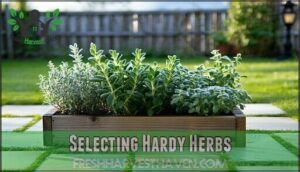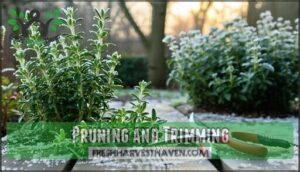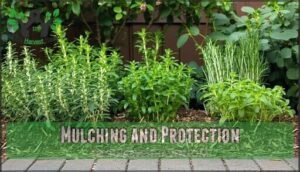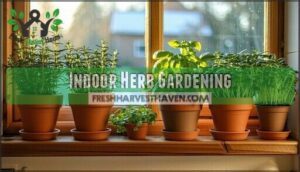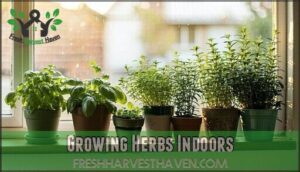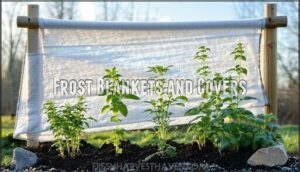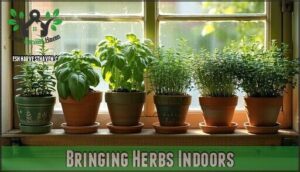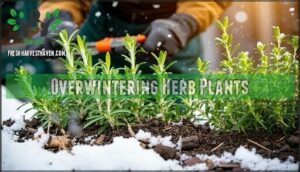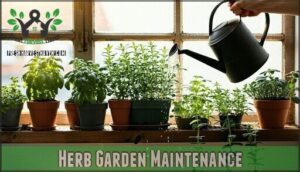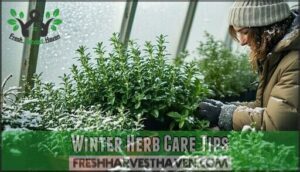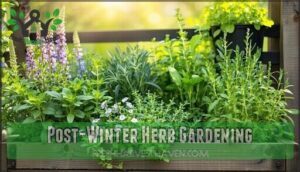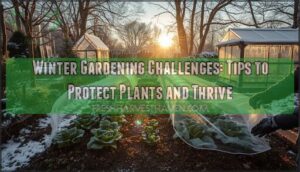This site is supported by our readers. We may earn a commission, at no cost to you, if you purchase through links.
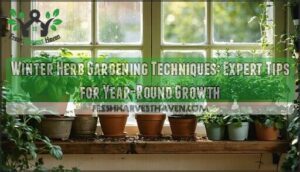 Winter herb gardening techniques require strategic adjustments to keep your green companions thriving through the cold months.
Winter herb gardening techniques require strategic adjustments to keep your green companions thriving through the cold months.
Start by relocating tender herbs like basil and cilantro indoors, where they’ll appreciate bright, south-facing windows or supplemental grow lights.
Hardy varieties like rosemary, thyme, and sage can brave outdoor conditions with proper mulching around their base.
Reduce watering frequency—soggy roots spell disaster in winter’s slower growth phase.
Skip fertilizing until spring awakens their metabolism.
For indoor herbs, maintain humidity levels around 40-50% and make certain good air circulation to prevent fungal issues.
Container herbs benefit from grouping together, creating their own microclimate.
The secret lies in understanding each herb’s cold tolerance and matching your care routine to winter’s slower rhythm.
Table Of Contents
- Key Takeaways
- Winter Herb Gardening Basics
- Selecting Hardy Herbs
- Preparing Herbs for Winter
- Indoor Herb Gardening
- Growing Herbs Indoors
- Protecting Herbs From Frost
- Overwintering Herb Plants
- Herb Garden Maintenance
- Winter Herb Care Tips
- Post-Winter Herb Gardening
- Frequently Asked Questions (FAQs)
- What is the best way to grow herbs in the winter?
- What herbs should be cut back for winter?
- What to do with thyme in the winter?
- How to grow herbs inside all year round?
- What herbs can survive freezing temperatures outdoors?
- How do you harvest herbs in winter?
- Can you grow herbs from kitchen scraps?
- What companion plants work with winter herbs?
- How do you preserve fresh herbs long-term?
- How often should I water herbs indoors?
- Conclusion
Key Takeaways
- Relocate tender herbs indoors – Move basil, cilantro, and other cold-sensitive herbs to bright, south-facing windows or supplement with grow lights before the first frost hits
- Protect hardy herbs with mulching – Apply 3-4 inches of organic mulch around rosemary, thyme, and sage, while keeping it 1-2 inches from stems to prevent rot
- Adjust your watering schedule – Reduce watering frequency since plants grow slower in winter, checking soil moisture by inserting your finger one inch deep before watering
- Stop fertilizing by early September – Cut off all fertilization to prevent tender new growth that won’t survive cold snaps and allow plants to naturally harden off for winter
Winter Herb Gardening Basics
Winter herb gardening transforms your home into a year-round culinary paradise, even when snow blankets your outdoor beds.
You’ll discover that with proper indoor techniques, ideal environmental conditions, and adequate lighting, fresh herbs can thrive throughout the coldest months, creating a culinary paradise.
Indoor Gardening Techniques
Transform your kitchen into a year-round herb haven using strategic indoor gardening techniques that maximize space and guarantee thriving plants. Indoor herb gardening succeeds when you combine vertical gardening systems with proper soil quality and supplemental lighting.
Your indoor herb sanctuary turns any home into a fresh flavor factory, no matter the season outside.
Your windowsill becomes a productive herb factory with the right setup.
Essential indoor herb care techniques include:
- Vertical Gardening: Install wall-mounted planters or tiered shelves to maximize space while guaranteeing adequate light exposure for each plant.
- Quality Potting Mix: Use well-draining soil with proper drainage holes to prevent root rot and promote healthy root development.
- Strategic Placement: Position herbs near south-facing windows where they’ll receive at least five hours of daily sunlight.
- Smart Grow Lights: Add LED grow lights** when natural light isn’t sufficient, especially during shorter winter days.
- Regular Herb Pruning**: Trim no more than one-third of each plant to encourage bushier growth and continuous harvesting throughout winter.
Proper indoor climate management and consistent watering prevent moisture buildup and fungal issues.
Optimal Temperature and Humidity
Your indoor herb garden thrives when you maintain Temperature Control between 60-70°F—think of it as creating a cozy Mediterranean microclimate.
Keep plants away from cold windows that can shock tender roots.
Humidity Levels around 40-50% prevent fungal nightmares, so use a humidifier or place water trays beneath pots.
Air Circulation is your secret weapon against mold formation in well-ventilated spots.
Monitor Soil Moisture and root temperature, as cold roots dramatically slow nutrient uptake and growth rates in your indoor herb gardening setup.
Lighting Requirements
Your herbs need proper lighting to thrive through winter’s shorter days.
Most herbs require at least five hours of bright light daily, so you’ll likely need supplemental lighting when natural light falls short.
LED grow lights work best, positioned 12-18 inches above plants for ideal coverage.
Full-spectrum options mimic natural sunlight effectively, while fluorescent lamp options suit smaller setups perfectly.
- LED lighting provides energy-efficient, long-lasting illumination with minimal heat output
- Light spectrum matters – full-spectrum bulbs support photosynthesis better than single-color options
- Greenhouse lighting techniques work indoors – rotate containers weekly for even exposure
- Shade management prevents leggy growth by ensuring all plant sides receive adequate light
Selecting Hardy Herbs
Choosing the right hardy herbs makes all the difference between a thriving winter garden and a collection of frozen disappointments.
These cold-tolerant champions not only survive harsh weather but also actually intensify their flavors when temperatures drop, giving you robust tastes that’ll make your winter cooking sing.
Rosemary and Thyme
When winter arrives, rosemary and thyme become your reliable Herb Pairing champions.
Rosemary Care requires USDA zones 7-10, while Thyme Harvest continues through December in most regions.
Both offer impressive Medicinal Benefits and Fragrance Uses that’ll keep your kitchen aromatic all season.
These overwintering herbs need well-drained soil and protection below 10°F.
Smart herb protection strategies include mulching and frost blankets.
Their natural resilience makes them perfect winter herb gardening tips for beginners seeking year-round freshness.
Sage and Oregano
Mediterranean champions sage and oregano pack serious winter herb gardening punch. Both herbs showcase impressive coldhardy resilience, thriving in well-draining soil while shrugging off frost’s bite.
Winter herbs refuse to be intimidated by frost—their flavors actually intensify when temperatures drop.
Sage’s velvety leaves deliver earthy, almost camphor-like notes that intensify during cold weather—perfect for winter harvest ventures. Its traditional medicinal uses extend beyond cooking, offering natural sage benefits for herbal preparations and cleansing rituals.
Oregano care involves regular harvesting to prevent flowering, which concentrates flavor profiles substantially. This herb pairing powerhouse delivers bold Mediterranean punch that complements sage’s mellow sophistication beautifully.
Both demonstrate remarkable herb winter protection qualities, with oregano’s hardy nature allowing continued growth even after losing some leaves to frost. These oregano uses make it invaluable for year-round culinary adventures.
Cold-Hardy Herb Varieties
Beyond rosemary care and thyme varieties, hardy perennials like chives and lavender thrive in USDA zones 3-7.
These coldhardy herbs laugh at winter’s worst tantrums while tender varieties surrender.
Oregano types survive harsh freezes, delivering fresh flavors when you need them most.
Sage benefits include exceptional cold tolerance, making cold climate gardening surprisingly rewarding for determined growers.
To guarantee a successful harvest, understanding winter herb gardening techniques is vital for maintaining healthy plants.
Preparing Herbs for Winter
Success in winter herb gardening starts with proper preparation timing—you’ll want to stop fertilizing by early September to prevent tender new growth that won’t survive cold snaps.
Strategic pruning after the first frost, combined with protective mulching, creates the foundation for herbs that’ll thrive through winter’s challenges.
Fertilizer Cutoff Period
Once you’ve selected hardy herbs for your winter garden, fertilizer timing becomes your next critical decision.
Stop all fertilization by late August to early September – this fertilizer cutoff prevents tender new growth that won’t survive frost. Fertilizer caution during this period allows plants to naturally harden off and enter dormancy.
Late fertilization schedules disrupt this natural nutrient cycle, reducing survival rates substantially.
Your soil prep should focus on maintaining existing nutrients rather than adding more.
This spring preparation strategy through proper cutoff dates guarantees your herbs develop the winter hardiness they need.
Herb fertilizing ends here, but soil balancing continues through mulching and protection methods.
Pruning and Trimming
Throughout the growing season, strategic pruning and trimming techniques guarantee your herbs survive winter’s harsh conditions while preparing them for vigorous spring growth.
Cut hardy perennials back to 4-6 inches after the first hard frost, when temperatures drop to 28°F or below. This targeted approach prevents disease while encouraging robust regrowth come spring.
Here are essential herb pruning techniques for winter preparation:
- Use clean, sharp pruning shears to prevent disease transmission between plants
- Time your herb trimming for morning hours when plant moisture levels are ideal
- Remove dead or damaged stems first, then shape remaining healthy growth using proper cutting techniques
- Cut just above leaf nodes to encourage new branching and bushier plants
- Perfect your harvest timing – collect leaves before cutting back for maximum flavor retention
Stop major pruning between early August and September to avoid stimulating vulnerable new growth that won’t survive freezing temperatures. Remember to stop fertilizing herbs by late August.
Mulching and Protection
After proper trimming, you’ll need to shield your herbs from winter’s harsh grip.
Apply 3-4 inches of organic mulch like straw or compost around each plant base, maintaining a 1-2 inch buffer from stems to prevent rot.
This soil insulation acts as your root guard, while frost blankets and winter covers protect foliage from wind damage.
Choose mulch types based on your herbs’ needs—pine needles work great for acid-loving varieties.
These mulching techniques create effective frost protection barriers that’ll keep your herbs thriving through winter’s worst tantrums.
Indoor Herb Gardening
When temperatures drop, you’ll need to master the art of moving your favorite herbs indoors for successful winter cultivation.
The key to thriving indoor herb gardens lies in selecting the right containers, ensuring proper drainage, and maintaining ideal growing conditions year-round.
Container Selection
Three simple guidelines transform your herb container game from amateur to expert level.
Your container choices directly determine whether your herbs thrive or merely survive winter’s indoor challenges.
Pot Size matters more than you’d think – cramped roots equal stressed plants.
Most herbs need 6-12 inches of width, giving their root systems breathing room to develop properly.
Container Depth should reach 8-10 inches for deep-rooted varieties like rosemary and sage.
Planter Materials offer distinct advantages:
- Terra cotta: Breathes naturally, preventing soggy soil conditions
- Plastic: Retains moisture longer, reducing watering frequency
- Ceramic: Provides excellent insulation for temperature stability
- Wood: Offers natural drainage while maintaining attractive aesthetics
Drainage Holes aren’t optional – they’re essential.
Multiple openings prevent waterlogged conditions that kill more indoor herbs than anything else.
Your Soil Mix needs somewhere to release excess water.
Smart container gardening starts with understanding these fundamentals.
When potting herbs, consider both current size and future growth potential.
Proper herb garden container care begins with selecting containers that support healthy root development and moisture management throughout winter’s challenging conditions.
Using the right herb planters can make a significant difference in the health and productivity of your indoor herb garden.
Soil and Drainage
Once you’ve got your containers ready, creating the perfect potting mix sets your herbs up for success. Start with a quality commercial blend that maintains soil pH between 6.0-7.0 for ideal nutrient uptake.
Organic matter like compost improves water retention while perlite or coarse sand prevents waterlogging—your herbs’ roots need air, not a swimming pool!
| Soil Component | Purpose | Ratio |
|---|---|---|
| Quality potting mix | Base nutrition | 60% |
| Perlite/coarse sand | Drainage systems | 25% |
| Compost | Organic matter | 15% |
Well-drained soil prevents root rot during winter’s slower growth period. Good soil drainage means water flows through but doesn’t pool at the bottom.
Soil pH management guarantees nutrients stay available when your herbs need them most. Mulching the surface helps maintain consistent moisture without creating soggy conditions.
Understanding soil preparation techniques is vital for a thriving herb garden. Remember, healthy soil health translates directly to thriving winter herbs that’ll keep your kitchen stocked all season long.
Humidity and Temperature Control
Temperature optimization serves as the cornerstone of successful indoor herb gardening.
You’ll want to maintain temperatures between 60-70°F for ideal growth, positioning plants away from cold windows to prevent freezing damage.
Humidifier Use becomes essential during winter months when dry air can stress your herbs.
Consider investing in Temperature Gauges to monitor conditions precisely.
Create beneficial microclimates by grouping herbs together, which naturally improves Air Circulation and Moisture Levels.
Place containers in wellventilated spots to prevent stagnant air while maintaining proper humidity control.
This strategic Climate Control approach guarantees your herb garden humidity optimization thrives year-round, giving you fresh herbs regardless of outdoor conditions.
Accurate temperature gauge readings are vital for maintaining perfect growing conditions.
Growing Herbs Indoors
Moving your herbs indoors during winter doesn’t mean settling for flavorless, wilted plants that barely survive until spring.
With the right lighting, watering schedule, and pest management strategies, you’ll maintain thriving indoor herb gardens that produce fresh flavors all season long, and this is key to having thriving indoor herb gardens.
Lighting and Ventilation
Winter’s shorter days don’t have to spell doom for your indoor herb garden. LED grow lights become your herbs’ lifeline, providing full-spectrum lighting that mimics natural sunlight for ideal photosynthesis. Position these lights 6-12 inches above your plants, running them 12-16 hours daily to compensate for reduced natural lighting.
Air circulation is equally important—proper ventilation systems prevent fungal issues that love stagnant air. Use small fans or guarantee well-ventilated spots to create fresh airflow that strengthens stems and prevents moisture buildup.
Here’s what proper lighting and ventilation deliver:
- Robust growth even when snow blankets your outdoor garden
- Disease prevention through consistent air movement
- Energy efficiency with modern LED options
- Stronger stems that won’t topple under their own weight
- Year-round harvests that keep your kitchen stocked with fresh herbs.
Your indoor herb garden thrives when you balance adequate grow lights with proper air circulation systems.
Watering and Fertilizing
Successful watering strategies start with checking soil moisture daily—stick your finger one inch deep into the soil.
If it’s dry, your herbs need water. Create a water scheduling routine that respects each herb’s unique needs: basil craves consistent moisture while rosemary prefers drier conditions.
Stop using fertilizer types by early September to prevent tender growth vulnerable to frost.
During winter months, reduce watering frequency but maintain humidity control by grouping plants together. This approach guarantees proper nutrient balance and supports healthy herb growth without encouraging cold damage through your herb fertilizing methods.
Pest and Disease Management
Your herbs’ watering schedule affects their vulnerability to pest control challenges.
Indoor environments create perfect conditions for herb pests like aphids, spider mites, and whiteflies that multiply rapidly in dry winter air.
Fungal diseases flourish when drainage fails—overwatering triggers root rot and fungus gnats that damage roots.
Weekly inspections of leaf undersides reveal early infestations before they spread.
Organic remedies like insecticidal soap effectively target soft-bodied pests without harsh chemicals.
Disease prevention requires immediate removal of dead foliage and maintaining proper air circulation around plants.
Natural pest deterrents work best when combined with ideal growing conditions—your herb garden pest control strategy succeeds through prevention rather than treatment.
Protecting Herbs From Frost
When winter’s chill threatens your herb garden, you’ll need smart protection strategies to keep your plants thriving through the cold months.
From frost blankets to strategic mulching, these techniques will shield your herbs from temperature drops and guarantee they’re ready to bounce back come spring.
Frost Blankets and Covers
When frost threatens to wipe out your herb garden, frost blankets serve as your first line of defense against winter’s bite. These lightweight, breathable covers create a protective microclimate that can raise temperatures by 6-12°F, effectively extending your growing season by several weeks.
Here’s how to maximize frost protection effectiveness:
- Apply covers in late afternoon to trap daytime warmth, then remove during sunny days for light exposure
- Secure edges tightly with stones or stakes to prevent cold air infiltration underneath
- Keep fabric off foliage to avoid cold transfer and potential plant damage
- Choose medium-weight materials that allow 60-70% light penetration while maintaining insulation
Row covers and cold frames work best when combined with proper timing and secure installation techniques.
Understanding frost blanket properties is essential for effective winter protection. Using the right frost blanket materials can make a significant difference in maintaining a healthy herb garden during winter.
Mulching and Insulation
Think of mulching as wrapping your herb garden in a cozy winter blanket.
Apply three to four inches of organic mulch around each plant’s base, keeping it one to two inches away from stems to prevent rot.
This soil insulation creates essential frost protection for your winter herb gardening success.
| Mulch Type | Best Application |
|---|---|
| Straw/Leaves | Hardy perennials like thyme and oregano |
| Wood Chips | Long-term root protection and heat retention |
| Compost | Nutrient-rich insulation with thermal benefits |
| Pine Needles | Acid-loving herbs requiring specialized care |
Root wrapping with winter covers plus proper mulching creates dual-layer protection that’ll keep your herbs thriving through harsh temperatures.
Bringing Herbs Indoors
When frost threatens, move your tender herbs indoors before the first freeze strikes.
You’ll need indoor pots with drainage holes and quality potting mix to prevent waterlogged roots. Position your indoor herb garden near south-facing windows for ideal herb lighting, or supplement with grow lights during darker months.
Space saving vertical arrangements maximize your growing area in compact kitchens. Monitor indoor climate conditions—maintain temperatures between 60-70°F with adequate humidity for thriving indoor herb cultivation.
Use humidity trays or group potted herbs together to create beneficial microclimates. This shift transforms your herbs from frost victims into flourishing indoor conditions champions.
With proper indoor gardening techniques, you’ll maintain fresh herbs throughout winter’s harshest months.
Overwintering Herb Plants
Successfully overwintering your herbs requires strategic timing and proper protection techniques that guarantee spring revival.
You’ll need to cut back hardy perennials, apply protective mulching, and propagate backup plants to guarantee a thriving herb garden survives winter’s harsh conditions, which is crucial for spring revival.
Cutting Back Perennials
When frost protection’s in place, your perennial herbs need proper pruning to survive winter’s harsh conditions.
Winter trimming isn’t just about cutting back growth—it’s strategic plant care that redirects energy to root systems where it’s most needed.
Here’s your winter herb care routine for cutting back perennials:
- Wait for first hard frost (28°F or below) before beginning any pruning techniques
- Cut hardy perennials to 4-6 inches above ground using clean, sharp cutting tools
- Remove all dead or diseased foliage to prevent pest overwintering and disease spread
- Trim woody herbs selectively, removing only damaged branches while preserving healthy growth
- Save viable seed heads from oregano and thyme for spring propagation projects
This herb garden pruning technique helps plants enter proper herb dormancy by eliminating energy drains from maintaining above-ground growth. Your perennial care routine should focus on clean cuts that heal quickly, preventing pathogen entry during cold months when plant renewal naturally slows.
Mulching and Protecting
After that first hard frost settles in, it’s time to tuck your herbs in for winter. Apply 3-4 inches of organic mulch around each plant, keeping it 1-2 inches away from stems to prevent rot. This soil insulation acts like nature’s sleeping bag for roots.
| Mulch Types | Benefits | Best For |
|---|---|---|
| Straw | Excellent airflow, easy removal | Most herbs |
| Compost | Adds nutrients, retains moisture | Heavy feeders |
| Wood chips | Long-lasting, weed suppression | Perennial beds |
| Pine needles | Acidic, lightweight | Acid-loving herbs |
Frost blankets and cold frames create protective microclimates that shield against temperature swings and drying winds.
Propagating New Plants
During winter’s dormant period, expanding your herb collection through propagation creates backup plants while slashing costs.
Winter’s slower growth rates actually improve rooting success for most herb propagation methods, giving you time to master these techniques.
Three proven propagation methods for winter success:
- Stem cuttings from rosemary, sage, and thyme root within 2-4 weeks when maintained at 65-75°F with humidity domes
- Seed saving from annual herbs like dill and cilantro when seed heads turn brown and make that telltale crackling sound
- Division of perennial herbs such as chives and mint achieves impressive 90% survival rates when performed indoors
Herb Garden Maintenance
Winter herb maintenance requires consistent attention to moisture levels and environmental conditions.
You’ll need to monitor soil moisture regularly since indoor heating systems can quickly dry out containers, while overwatering becomes a bigger risk when plant growth slows down.
Monitoring Soil Moisture
Checking your moisture levels becomes second nature with proper soil testing techniques.
Insert your finger one inch deep into the soil twice weekly – if it’s dry, it’s time to water.
Winter’s slower evaporation means less frequent watering than summer, preventing root rot from soggy conditions.
Watch for yellowing leaves or musty odors signaling overwatering.
Mediterranean herbs like rosemary prefer drier soil, while basil needs consistent moisture management.
Indoor humidity control affects how quickly soil dries, so monitor both factors together for ideal water balance in your winter herb garden.
Adjusting Watering and Humidity
Your herb garden’s moisture balance becomes a balancing act when winter’s dry air meets dormant soil moisture needs. Water Levels should decrease substantially—check that top inch of soil and water only when it’s dry to the touch.
Overwatering kills more herbs than underwatering, especially when root rot prevention is your top priority.
Create Humid Zones around your plants by grouping them together or using pebble trays filled with water. Air Circulation prevents stagnant moisture that invites fungal problems, so keep a small fan running nearby.
Fogging Systems work well for larger collections, but simple moisture management techniques like placing plants away from heating vents often suffice.
Remember that winter herb gardening requires patience—your herbs are conserving energy, not growing aggressively.
Good drainage and proper mulching around outdoor plants help maintain consistent moisture without waterlogging. Room-temperature water prevents shocking tender roots during these sensitive months.
Winter Herb Care Tips
Managing winter herb care requires attention to three critical areas that can make or break your indoor garden’s success.
You’ll need to balance moisture levels, temperature control, and pest prevention to keep your herbs thriving through the coldest months, which involves understanding the importance of temperature control.
Preventing Root Rot
Four critical factors determine whether your herbs thrive or die from root rot prevention during winter months.
Root rot develops when waterlogged soil creates oxygen-starved conditions, turning healthy white roots into mushy, blackened tissue that smells like decay.
Your defense against moisture damage requires systematic attention to these fundamentals:
- Proper Drainage – Select containers with multiple holes and elevate pots on saucers with gravel
- Soil Quality – Use well-drained soil mixtures containing perlite, vermiculite, or coarse sand
- Water Management – Test soil moisture 1-2 inches deep; water only when slightly dry to touch
- Humidity Control – Maintain 40-50% humidity levels using fans or dehumidifiers near plant clusters
- Root Care – Inspect root systems monthly for early detection of soft, discolored, or foul-smelling tissue
Think of drainage like plumbing – if water can’t escape, pressure builds and pipes burst.
Your herbs need that same escape route through proper drainage systems to prevent catastrophic root failure.
Managing Pests and Diseases
While proper drainage prevents root rot, watchful eyes prevent pest invasions.
Common winter culprits include aphids clustering on rosemary stems, spider mites lurking beneath leaves, and white mold flourishing in humid conditions.
Regular weekly inspections catch problems early—your best defense against unwanted garden guests.
| Pest/Disease | Natural Remedies |
|---|---|
| Aphids | Neem oil spray, beneficial insects |
| Spider mites | Horticultural oil, increased humidity |
| White mold | Baking soda solution, improved airflow |
| Root rot | Reduce watering, enhance drainage |
Organic Methods work wonders for Disease Prevention.
Mix homemade 2% oil-and-soap solutions for Pest Control, or introduce ladybugs for biological management.
These Natural Remedies protect your herbs without harsh chemicals, keeping your winter harvest safe and flavorful.
Promoting Healthy Growth
Success breeds success when you master these winter herb gardening tips. Your herbs won’t just survive—they’ll thrive with proper attention to fundamentals.
Soil Quality forms your foundation. Well-draining, nutrient-rich potting mix prevents waterlogged roots while supporting robust Root Development. Test pH levels monthly; most herbs prefer slightly alkaline conditions around 6.5-7.0.
Water Balance requires finesse—think "consistently moist, never soggy." Check soil moisture by inserting your finger one inch deep. If it’s dry, water thoroughly until drainage occurs.
Strategic Pruning Techniques encourage bushier growth patterns. Remove no more than one-third of plant material at once, focusing on leggy stems and dead foliage.
Nutrient Supply stays minimal during winter months. Light feeding every 6-8 weeks maintains vigor without forcing tender growth that’s vulnerable to cold damage.
- Monitor soil drainage to prevent root rot
- Maintain consistent moisture without overwatering
- Prune strategically for compact, healthy growth
- Feed lightly during dormant periods
These herb garden maintenance practices guarantee your herb propagation techniques succeed throughout winter’s challenges.
Post-Winter Herb Gardening
As winter fades, you’ll need to assess your herb garden’s condition and prepare it for the growing season ahead.
Spring revival starts with careful evaluation of what survived the cold months and strategic pruning to encourage vigorous new growth, which is a key part of the growing season.
Spring Pruning and Trimming
After surviving winter’s harsh conditions, spring awakens your herb garden’s potential for spectacular renewal.
Sharp pruning shears become your transformation tools for effective spring trimming and garden cleanup. Begin by removing brown, damaged foliage to improve air circulation and prevent disease. Cut hardy perennials back to healthy growth points, encouraging vigorous new shoots.
| Pruning Timing | Technique |
|---|---|
| Early spring (after last frost) | Remove dead/damaged stems first |
| Mid-spring | Cut back to 4-6 inches above ground |
| Late spring | Light trimming for shape |
This plant rejuvenation process requires precise herb pruning techniques—never remove more than one-third of the plant at once. Proper herb garden pruning through strategic herb renewal revitalizes your garden’s productivity. Effective herb garden maintenance is essential for promoting healthy growth and preventing common issues.
Dividing and Rejuvenating
After winter’s harsh grip loosens, it’s time to give your herb garden revival a jumpstart through strategic plant division.
Overcrowded perennials like chives, mint, and oregano practically beg for root pruning every 2-3 years when their vigor wanes.
Simply dig up established clumps, split root masses with clean shears, and replant divisions in fresh, compost-enriched soil.
This herb rejuvenation technique doubles your garden while boosting plant health naturally.
Starting New Herb Seeds
Between winter’s end and spring’s promise, you’ll discover endless herb garden possibilities through strategic seed starting.
Begin this indoor herb garden journey six to eight weeks before your last frost date, giving seedlings ample development time. Quality seed starting mix and proper containers create the foundation for successful herb propagation methods.
- Seed Selection: Choose climate-adapted varieties like basil, cilantro, and parsley that’ll thrive in your specific growing zone
- Soil Preparation: Use sterile seed starting mix with excellent drainage to prevent damping-off disease in delicate seedlings
- Germination Tips: Maintain consistent 65-70°F temperatures and gentle moisture for reliable sprouting success
These winter herb gardening techniques transform tiny seeds into robust plants ready for transplanting.
Your sowing techniques and seedling care during this pivotal period determine whether you’ll harvest abundant herbs or face disappointing failures come summer.
Frequently Asked Questions (FAQs)
What is the best way to grow herbs in the winter?
Like a greenhouse extending summer’s embrace, you’ll bring tender herbs indoors while protecting hardy ones outdoors with mulch and covers. Focus on drainage, proper lighting, and maintaining 60-70°F temperatures.
What herbs should be cut back for winter?
You’ll want to cut back hardy perennials like thyme, oregano, rosemary, and sage to 4-6 inches after the first hard frost hits 28°F.
This prevents winter damage while promoting healthy spring regrowth.
What to do with thyme in the winter?
Thyme’s hardy nature makes it surprisingly resilient in cold weather.
You can leave it outdoors with minimal protection – just mulch around the base and trim back after first frost to encourage spring regrowth.
How to grow herbs inside all year round?
You’ll succeed by providing proper lighting, well-draining soil, and consistent temperatures between 60-70°F.
Use grow lights, maintain humidity with water trays, and harvest regularly to encourage bushy growth throughout the seasons.
What herbs can survive freezing temperatures outdoors?
Cold-hardy herbs like thyme, rosemary, and sage can survive freezing temperatures. These Mediterranean marvels withstand frost and snow, while oregano and parsley also tolerate cold conditions with proper mulching protection.
How do you harvest herbs in winter?
Harvest perennial herbs like rosemary, thyme, and sage throughout winter by cutting small amounts in morning hours.
These hardy plants withstand frost and snow, allowing continuous harvesting for fresh culinary use.
Can you grow herbs from kitchen scraps?
Like telegraphing your grandmother’s garden secrets, you can absolutely grow herbs from kitchen scraps.
Green onions, basil, mint, and cilantro root easily in water.
Simply place stem cuttings in a glass, change water regularly, and watch roots develop within days.
What companion plants work with winter herbs?
You’ll want to pair your winter herbs with cold-hardy companions like garlic, onions, and kale. These plants share similar growing conditions and won’t compete aggressively for nutrients or space.
How do you preserve fresh herbs long-term?
Like treasure locked in a vault, fresh herbs hold their essence through strategic preservation methods.
You’ll freeze them in ice cubes, dry bundles upside-down, or freeze-dry whole leaves for maximum flavor retention throughout winter.
How often should I water herbs indoors?
Water indoor herbs when the top inch of soil feels dry to touch. Most herbs need watering every 2-3 days, but check soil moisture regularly since indoor conditions vary substantially.
Conclusion
Mastering winter herb gardening techniques isn’t rocket science—despite what your frozen basil might suggest.
You’ve learned to relocate tender herbs indoors, protect hardy varieties with mulch, and adjust watering schedules for dormant growth.
Remember: successful overwintering depends on understanding each herb’s cold tolerance and creating appropriate microclimates.
With proper lighting, humidity control, and frost protection, you’ll maintain fresh herbs throughout winter’s challenging months while preparing for spring’s abundant growth.

